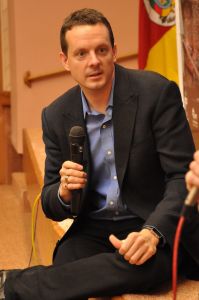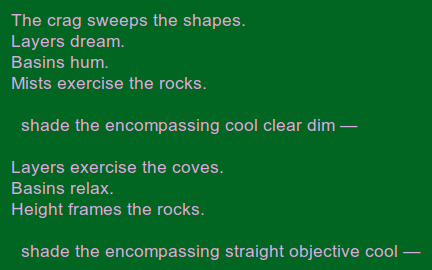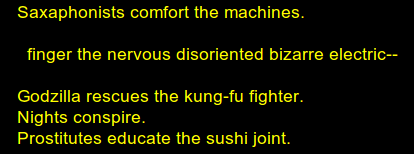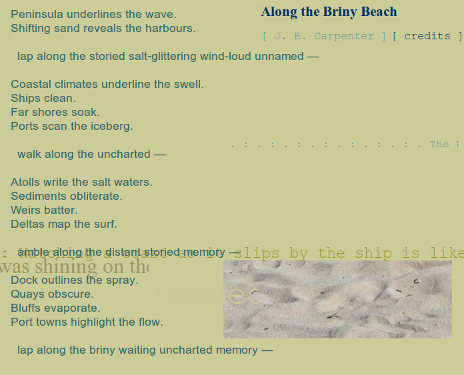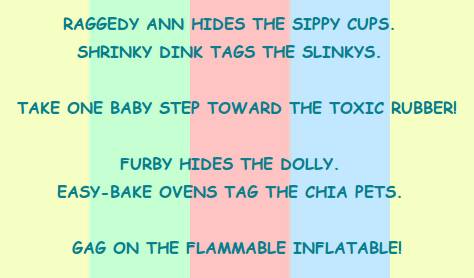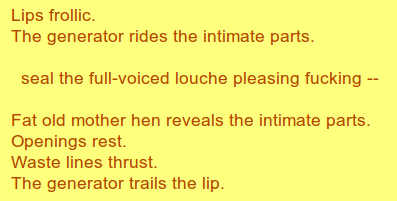Here’s another article about my talk today in Passo Fundo. It’s in Brazilian Portuguese, and has a less maniacal photo accompanying it than did the last article I mentioned. The Babelfish provides this translation into English.
MIT Seeks Asst Prof in Science Writing
MIT’s Program in Writing and Humanistic Studies, in the School of Humanities, Arts and Social Sciences, is seeking a tenure-track assistant professor in science writing to start in the Fall of 2012. The Program offers undergraduate courses in science writing and a one-year Master’s degree program in Science Writing. Candidates for the new tenure-track position should have significant publications, productions, or research; and/or advanced degrees combined with demonstrated accomplishment in the public communication of science. The field of specialization may be in science writing for the public, science writing/production in audio, video and or new/digital media, long-form science writing, and/or journalism about science, technology/engineering, environment, health and medicine. Teaching experience is valuable, but not required. Applicants should apply via AcademicJobsOnline, by November 1, 2011. The selection committee will begin reviewing applications in November and schedule interviews in December 2011. MIT is an affirmative action, equal opportunity employer.
Electrifying Literature: The ELO 2012 Conference at WVU
Call for Proposals…
ELO 2012
Electrifying Literature
Affordances and Constraints
June 20-23, 2012
Morgantown, WV
Conference Planning Committee
– Sandy Baldwin, West Virginia University (Chair)
– Philippe Bootz, University of Paris 8
– Dene Grigar, Washington State University Vancouver
– Margie Luesebrink, Irvine Valley College
– Mark Marino, University of Southern California
– Stuart Moulthrop, University of Wisconsin, Milwaukee
– Joseph Tabbi, University of Illinois, Chicago
We invite titles and proposals of no more than 500 words, including a brief description of the content and format of the presentation, and contact information for the presenter(s). Send proposals to elit2012 [at] gmail.com, using plain text format in the email, or attached as Word or PDF. All proposals will receive peer-to-peer review by the ELO and will be considered on their own terms. Non-traditional and traditional formats will be subject to the same peer-to-peer review process.
Submission deadline for proposals: November 30, 2011
Notification of acceptance: December 30, 2011
Electronic Literature: Where is It?*
The 2012 Electronic Literature Organization Conference will be held June 20-23, 2012 in Morgantown, WV, the site of West Virginia University. In conjunction with the three-day conference, there will be a juried Media Arts Show open to the public at the Monongalia Arts Center in Morgantown and running from June 18-30, 2012. An accompanying online exhibit will bring works from the ELO Conference to a wider audience.
Even if nobody could define print literature, everyone knew where to look for it – in libraries and bookshops, at readings, in class, or on the Masterpiece channel. We have not yet created, however, a consensus about where to find electronic literature, or (for that matter) the location of the literary in an emerging digital aesthetic.
Though we do have, in digital media, works that identify themselves as “locative,” we don’t really know where to look for e-lit, how it should be tagged and distributed, and whether or how it should be taught. Is born digital writing likely to reside, for example, in conventional literature programs? in Rhetoric? Comp? Creative Writing? Can new media literature be remediated? How should its conditions of creation be described? Do those descriptions become our primary texts when the works themselves become unavailable through technological obsolescence?
To forward our thinking about the institutional and technological location of current literary writing, The Electronic Literature Organization and West Virginia University’s Center for Literary Computing invite submissions to the ELO 2012 Conference to be held from June 20-23, 2012, in Morgantown, West Virginia.
Bearing in mind the changing locations of new media literature and literary cultures, the conference organizers welcome unconventional presentations, whether in print or digital media. The point is not to reject the conventional conference ‘paper’ or bullet point presentation but to encourage thoughtful exploration and justification of any format employed. All elements of literary description and presentation are up for reconsideration. The modest mechanisms of course descriptions, syllabus construction, genre identification, and the composition of author bios, could well offer maps toward the location of the literary in digital media. So can an annotated bibliography of works falling under a given genre or within a certain technological context. We welcome surveys of the use of tags and keywords, and how these can be recognized (or not) by readers, libraries, or other necessary nodes in an emerging literary network Also of interest is the current proliferation of directories of electronic literature in multiple media, languages, and geographical locations.
The cost of the conference is $150; graduate students and non-affiliated artists pay only $100. The cost covers receptions, meals, and other conference events. All participants must be members of the Electronic Literature Organization. All events are within walking distance of the conference hotels. Morgantown is a classic college town, located in the scenic hills of north central West Virginia, about 70 miles south of Pittsburgh, PA. Local hotel and travel information will be available on the conference website starting October 1, 2011.
Check http://el.eliterature.org and http://conference.eliterature.org for updates. For more information, email elit2012 [at] gmail.com.
*Note: this title derives from an essay by ELO Board Member Dene Grigar in electronic book review, where selected conference presentations will be published within a few months of the conference.
Yo Conceptualists
Christian Bök is nearing completion of his 9-year Xenotext project.
Craig Dworkin edited Against Expression: An Anthology of Conceptual Writing with Kenneth Goldsmith; it came out early this year.
Kenneth Goldsmith has a new interview up at the Academy of American Poets site.
Vanessa Place has now published two books of her trilogy Tragodía: Statement of Facts and Statement of the Case.
Who Grabbed My Gorge
In January 2009, I wrote a very short (one page) Python poetry generator that creates a limitless nature poem each time it is run. I wrote this generator, “Taroko Gorge,” mostly at Taroko Gorge National Park in Taiwan, finishing it on the plane afterwards. I later ported it to JavaScript so that it could be easily run in a Web browser.
It seems the gorge goes ever ever on. The code from “Taroko Gorge” and the form it defines have been appropriated a few times. Here are five poetry generators that use the code from that project and replace my text with different, and often much more extensive, language:
“Tokyo Garage” by Scott Rettberg, 2009. [Output from “Tokyo Garage” read aloud by a pedantic machinima clown.]
“Gorge” by J. R. Carpenter, 2010. [Announcement of “Gorge.”] [Output appears in J. R. Carpenter’s GENERATION[S], Traumawien: 2010.]
“Along the Briny Beach” by J. R. Carpenter, 2011. [Announcement of “Along the Briny Beach.”]
“Toy Garbage” by Talan Memmott, 2011.
“Yoko Engorged” by Eric Snodgrass. 2011. [Announcement of “Yoko Engorged.”]
Neural on Sea and Spar
Thanks to Neural.it, the very long-running, vigorously-firing Italian site and magazine on digital media art and related topics. This publication did a writeup of my and Stephanie Strickland’s poetic system Sea and Spar Between. It’s available in English and in Italian.
Concrete Perl
h d d k x v d r k y p s b a b a n i k d u u
v r c q i e z j s s v h t l i r k k n k n n m
z b q b k x m d u z f s g p u z v y v m f s
i u p p z r n t k f b h v q l x w h x f x c i w v f
k h l a i o q s z n z u n c l w d a d a m j b e
m n b q o u o e n s r b o j b q q t q s f n i f u l
Concrete Perl
a set of four concrete poems realized as 32-character
Perl programs
by Nick Montfort
– All the Names of God
– Alphabet Expanding
– ASCII Hegemony
– Letterformed Terrain
You can download the linked Perl files and/or simply copy and paste the following four lines, which correspond to the four titles above:
– perl -e '{print"a"x++$...$"x$.,$,=_;redo}'
– perl -e '{print$,=$"x($.+=.01),a..z;redo}'
– perl -e '{print" ".chr for 32..126;redo}'
– perl -e '{print$",$_=(a..z)[rand$=];redo}'
For purposes of determining the platform precisely and counting characters, the rules of Perl Golf are
used. These rules, for instance, do not count the (optional) newline at the end of a one-line program. The Concrete Perl programs work on all standard versions of Perl 5.8.0 and have been verified as 32 characters long using a count program.
These programs are also written to work and to be visually pleasing on terminal windows (or terminals) of any geometry.
To present them all at once, you can tile four windows and run one program in each window. For instance, running Linux with Compiz as the window manager and the Grid plugin installed and active, create four windows and assign them to the four corners of the screen using Ctrl-Alt-Num Pad 7, Ctrl-Alt-Num Pad 9, Ctrl-Alt-Num Pad 1, and Ctrl-Alt-Num Pad 3. In this
mode if the resolution of the display is not particularly high, you may wish to decrease the font size a notch in each window.
Concrete Perl was released onto the demoscene and discussed by me for the first time in my talk “Beyond Data-Driven Poetry: ppg256 and Concrete Perl,” on the panel “Literary Practice and the Digital Humanities, Redux: Data as/and Poetry,” Digital Humanities 2011, Stanford, June 22, 2011.
I have printed the four programs/poems on a dot matrix printer on business cards and am handing them out and, in some cases, adding them to the “Interactive Poetry Wall” at Stanford University’s “Coho” coffeehouse.
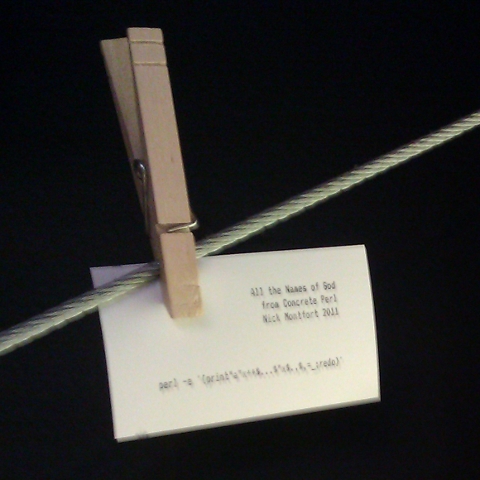
p j o c v v n v t g k t i s h f j v e d v c e b
p z p e s s d o f z v p s t z i b f j w l
p z y f j w k k p k y n v f g u m r m k x i w l s a t n b a f
w q y u t p r p w p m d x j c j j n z k a j z i s
w a w q k j y y k c r d i b p f z h i x i
c o x f p f u d g z y f b y v q v g v o j l
World’s Hottest Platforms 2011
Ian Bogost and I were thinking about the Platform Studies series today, as we are wont to do. There are two books in the series that are nearing completion now, which we are delighted about, but there are many more to be written. We were talking about some platforms that we thought were large and low-hanging fruit for any interested authors – ones that would be great to write about. These are a few platforms or families of platforms that seem to us to have interesting technical aspects, diverse and important historical connections, a good amount of worthwhile cultural production, and a number of adherents:
– Apple II
– BASIC
– Commodore 64
– Flash
– Game Boy and/or Game Boy Advance
– iPhone and iPad
– Java
– Macintosh
– MSX
– NES
– PC
– System/360
– Unix and Linux
– Windows (“Wintel”)
In case there’s anything that seems puzzling about this list: A platform, as far as the Platform Studies series is concerned, is something that supports programming and programs, the creation and execution of computational media. (This is pretty much what Wikipedia defines as a computing platform, too.) So BASIC, Java, and Flash are as much platforms as the mainly-hardware consoles and computers that are listed, as are the operating systems on the list.
If any of these interest you enough that you’d consider writing a book about them, please contact me and/or Ian. If you have a favorite platform that we haven’t mentioned and want to suggest that someone write about it, please leave us (and any potential authors who are reading) a comment.
“Wheel On” in Downtown Buffalo
I’m here in Buffalo for the E-Poetry Festival at UB. Last night I got to present work downtown at the Sqeuaky Wheel, a media arts center that has been helping artists produce video, film, and digital work since 1985.
With my collaborator Stephanie Strickland, I presented “Sea and Spar Between,” our recent poetry generator which offers an unusual interface to about 225 trillion stanzas arranged in a lattice.
The full program for the evening included Alan Bigelow’s presentation of his “This Is Not a Poem,” which allows you to become a “treejay” and modify Joyce Kilmer’s “Trees”; a presentation of the voice-acted, distributed disaster narrative L.A. Flood project by Mark Marino; and a tribute to Millie Niss presented by her mother and collaborator, Martha Deed. These were followed by a very nice set of motion pictures, including, for instance, Ottar Ormstad’s “When,” featuring hulks of cars, the lowercase letter y, and the color yellow.
It was great to present with Stephanie in this context. Thanks particularly to Sandy Baldwin for introducing us and to Tammy McGovern at the Squeaky Wheel for hosting us.
“Indy” Text Adventures in the Eastern Bloc
Interactive fiction aficianados who aren’t at MiT7 (Media in Transition 7) and who thus missed Jaroslav Svelch’s excellent presentation – please check out the corresponding paper which he’s helpfully placed online: “Indiana Jones Fights the Communist Police: Text Adventures as a Transitional Media Form in the 1980s Czechoslovakia.”
NAFTA Party
A collaborative story by Jesse Ashcraft-Johnson, Eleanor Crummé, Alex Ghaben, Cisco Gonzales, Ray Gonzalez, Boling Jiang, Nick Montfort, Shannon Moran, Kirsten Paredes, Carter Rice, Tyler Wagner, and Jia Zhu
“Mr. President, can you summarize the events of the G-6 conference?”
“First, a bunch of world leaders surrendered their favorite prostitutes. Then, we all yelled ‘Yeehaw!'” That was what George H. W. Bush thought, anyway, as he delivered a quick straight answer to the question.
“Mr. President, what was your holiday message to the troops?”
“I told the boys: either step up to the challenge or there will be no Christmas presents this year.”
When the photo-op smiles fell away, there was a moment of hesitation between Bush, Canadian Prime Minister Mulroney and Mexican President Salinas. The prepared statements about NAFTA were left on the podium, the talking points and teleprompters left in the press room with the reporters. Music swelled outside closed doors. “Well — either we dance or we lose ourselves in emerging global markets!” Bush blurted out, the twang in his voice inviting them to the hoedown.
Whiskey heavy on his breath, Bush turned to Salinas and elbowed him playfully. “Were you tutoring someone last night in long division? Either that was a very short 18-year-old or you might want to go see a priest. I hear they’re good with that sort of thing.”
He felt Mulroney’s eyes on him and turned abruptly. “Do you have a staring problem, boy? You’re looking at me like a damn homosexual. Either you face me like a man or spend the night. I’ll pound you ’till you’re tender.”
Mulroney flashed a smile, then started. A SWAT team was scaling the White House wall. “Look!” he said, gripping President Bush’s hand. “Either monkeys are flying out of your butt, or we should really rethink what we told the police last night. Maybe that anonymous call to the FBI tip line about hiding little boys in the attic wasn’t such a great idea.”
As their hands touched, Bush remembered the secret NAFTA initiation ceremony of the previous night.
Salinas had been pouring shots of tequila for a while. Stumbling up on top of the table, Bush called for attention and announced: “In order to promote unity, we must remove all barriers to our freedom. That includes our clothing.” Salinas nodded gravely, adding, “we must be pure and unfettered in body as well as soul.” There were noises of confusion from the others gathered there. “Hey, I’m from Texas, bitches. This is how we roll. Go big or go home!” Mulroney reached deep into his pants and pulled out a 12-ounce bottle of maple syrup. “Big enough for you, Bush?” he shouted as he chugged it down with a giant sucking sound.
One thing led to another. In the darkness, having slipped past the Secret Service, they ended up joining hands while riding bicycles naked down Pennsylvania Avenue.
Bush was snapped out of his reverie by the arrival of the NAFTA treasurer who had come to brief the world leaders, who were inebriated once again, on the state of the budget.
“First, take off your clothes,” Bush told him. “Then we’ll talk … ”
Imagination Fit to Print
If you’re heading over to look at today’s parodical “Final Edition,” allow me to suggest instead a thoughtful and compelling re-imagination of the New York Times, the special edition of July 4, 2009 by the Yes Men and the Anti-Advertising Agency. Instead of being just a joke that falls flat – one that was released on the 11th day of the month and features a New York skyscraper in flames, very tastefully – the latter “fake” newspaper is actually a productive utopian vision.
I don’t mind when parodists do the end times, but I think we should at least do them right. Take a look at the last daily page from Suck.com, or, if you want to go back to the 20th century and bust out the microfiche, the final, April 24, 1966 issue of the New York Herald Tribune. (A predecessor of that merged newspaper has a square in New York named after it, as does the Times.) Those who consciously put togther a final edition often strive for summing up, even if their organization is in the final stages of falling apart. Last issues tend to be rich in history and thoughtful about the future.
I don’t see an online record of this quip, but I recall Bruce Sterling (perhaps in the context of the Dead Media Project) stating that being first isn’t nearly as difficult as being last. To be the last in a category means enduring, and continuing to endure, as all others drop away. Even to be writing the last issue of an important newspaper or other serial means to be concluding a tremendous accumulation of context, conventions, and expectations. When it comes, the last issue of the New York Times will be a swan song, not a belly flop. I’d love to see some serious imagination of what that will be like.
Records of Oulipolooza
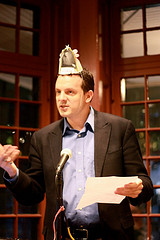 Video and audio of Oulipolooza, a festive tribute to the Oulipo in which I participated, is now online. The event was held on March 15, 2011 at the Kelly Writers House at Penn and was organized by Michelle Taransky and Sarah Arkebauer. Speakers were:
Video and audio of Oulipolooza, a festive tribute to the Oulipo in which I participated, is now online. The event was held on March 15, 2011 at the Kelly Writers House at Penn and was organized by Michelle Taransky and Sarah Arkebauer. Speakers were:
KATIE PRICE
LOUIS BURY
JEAN-MICHEL RABATÉ
GERALD PRINCE
and NICK MONTFORT
It was quite an honor to be part of this group, which included one of my Ph.D. advisors – Gerry Prince. I may have been the least distinguished Oulipo scholar among these speakers, but I tried to make up for that by being the only one to wear a party hat.
An Amazing Linked List
I strongly encourage those of you who haven’t seen it yet to check out Brian Kim Stefans’s Introduction to Electronic Literature: a freeware guide.
Right now it is “just” a list of links to online resources, from Futurism through 2010, that are relevant to understanding different important aspects of electronic literature – making it, reading it, sorting through different genres, and understanding its historical connects.
It’s extremely useful in this form, but Stefans is also hoping to put these selections together in a Lulu.com book that he’ll sell at cost. To that end, he’s selected only texts – work that will fit in a book – as opposed to pieces that need to be read on a networked computer. Stefans also intends to put together a website that collects and mirrors these writings, uniformly typeset in a legible way, as PDFs.
I’m of course pleased that Stefans was inspired by The New Media Reader, which Noah Wardrip-Fruin and I edited for the MIT Press, and that he included a few of my pieces.
As I have a strong preference for assigning publicly available texts instead of scanned articles that live being a university paywall, I find these texts very useful for teaching. Stefans is taking suggestions for how to revise his Introduction over on his netpoetic.com post.
My Curveship Talk at PAX-East 2011
I gave a talk about Curveship in the “IF Suite” (actually an ordinary hotel room with a few upturned beds, not a suite) at PAX-East 2011 earlier this month. It was great to present to fellow IF author/programmers from around the world at this event, which was effectively the second annual Festival of Interactive Fiction. The IF Summit was organized by Andrew Plotkin, a.k.a. Zarf, once again this year. Thanks to Jason McIntosh, there’s pretty good-quality video (very good, considering the ramshackle setup) of the first 22.5 minutes of my talk:
The parts where I actually demo the system and discuss how games are written are missing, unfortunately, but my comments do introduce Curveship and its motivation.
Also check out the video documentation of the “Setting as Character” panel with Andrew Plotkin, Rob Wheeler, Stephen Granade, and Dean Tate. (This one took place in the more capacious Alcott Room, which we had on Saturday, March 12 thanks to Dave Cornelson.) Also, there’s video of the panel on “Non-Gamers Gaming,” with Caleb Garner, Tim Crosby, Heather Albano, Sarah Morayati, and Andrew Plotkin.
La Muchacha y el Lobo


In 2001, Beehive was the first Web publication to print a creative digital media piece of mine, “The Girl and the Wolf.” I had written this story back in 1997 in Janet Murray’s Interactive Narrative class at MIT. (These days, I teach this class here at MIT.) It was strongly inspired by the readings of folk tales we had done in Henry Jenkins’s Children’s Literature class. “The Girl and the Wolf” is a very early creative piece of mine, but I remain pleased with the systematic concept and with what I wrote. It’s a simple arrangement of nine versions of a story, allowing the levels of sex and violence to be increased independently. With some contemporary references and a few other turns of phrase, I introduced only a few deviations from well-known folkloric versions of the Little Red Riding Hood story.
Ruber Eaglenest has now translated this “variable tale” into Spanish as “La Muchacha y el Lobo.”
Eaglenest describes himself as a “wannabe” game programmer, but has participated in the Spanish IF community in many ways using the name El Clérigo Urbatain. In addition to writing many reviews and articles and doing several interviews, he has written and collaborated on several pieces of interactive fiction: Por la necedad humana, Astral, Aventurero en el Sega Park, El extraño caso de Randolph Dwight, and an episode of El museo de consciencias. He has also adapted several interactive fiction games and translated several to Spanish – most recently, Graham Nelson’s Relics of Tolti-Aph.
Eaglenest has also provided a lengthy and very useful post about the Little Red Riding Hood story and “The Girl and the Wolf” on his blog (in Spanish).
Rettberg on After Parthenope
If you’re interested in story generation or Processing, do check out Scott Rettberg’s new screencast describing the process he undertook in writing and programming After Parthenope. He goes through the nuts and bolts of the piece and how it rolls out language using a hand-crafted trigram model; he also explains some of the pleasures of authoring a system like this.


